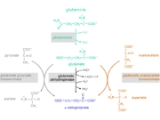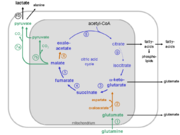
Glutaminolysis
Encyclopedia
Glutaminolysis is a series of biochemical reactions by which the amino acid glutamine
is degraded to glutamate, aspartate, CO2, pyruvate, lactate
, alanine
and citrate
.
and the malate-aspartate shuttle
.
 1. Hydrolysis of the amino group of glutamine yielding glutamate and ammonium
1. Hydrolysis of the amino group of glutamine yielding glutamate and ammonium
.
Catalyzing enzyme: glutaminase
(EC 3.5.1.2)
2. Glutamate can be excreted or can be further metabolized to α-ketoglutarate.
For the conversion of glutamate to α-ketoglutarate three different reactions are possible:
Catalyzing enzymes:

catalyzing enzyme: α-ketoglutarate dehydrogenase complex
catalyzing enzyme: succinyl-CoA-synthetase, EC 6.2.1.4
catalyzing enzyme: succinate dehydrogenase, EC 1.3.5.1
catalyzing enzyme: fumarase
, EC 4.2.1.2
catalyzing enzyme: malate dehydrogenase
, EC 1.1.1.37 (component of the malate aspartate shuttle)
catalyzing enzyme: citrate synthase
, EC 2.3.3.1
according to the following equations:
cells. In tumor cells the citric acid cycle is truncated due to an inhibition of the enzyme aconitase
(EC 4.2.1.3) by high concentrations of reactive oxygen species
(ROS) Aconitase catalyzes the conversion of citrate to isocitrate.
On the other hand tumor cells over express phosphate dependent glutaminase and NAD(P)-dependent malate decarboxylase, which in combination with the remaining reaction steps of the citric acid cycle from α-ketoglutarate to citrate impart the possibility of a new energy producing pathway, the degradation of the amino acid glutamine to glutamate, aspartate, pyruvate CO2, lactate and citrate.
Besides glycolysis
in tumor cells glutaminolysis is another main pillar for energy production. High extracellular glutamine concentrations stimulate tumor growth and are essential for cell transformation. On the other hand a reduction of glutamine correlates with phenotypical and functional differentiation
of the cells.
Due to low glutamate dehydrogenase and glutamate pyruvate transaminase activities, in tumor cells the conversion of glutamate to alpha-ketoglutarate mainly takes place via glutamate oxaloacetate transaminase.
Glutamine
Glutamine is one of the 20 amino acids encoded by the standard genetic code. It is not recognized as an essential amino acid but may become conditionally essential in certain situations, including intensive athletic training or certain gastrointestinal disorders...
is degraded to glutamate, aspartate, CO2, pyruvate, lactate
Lactate
Lactate may refer to:*The act of lactation*The conjugate base of lactic acid...
, alanine
Alanine
Alanine is an α-amino acid with the chemical formula CH3CHCOOH. The L-isomer is one of the 20 amino acids encoded by the genetic code. Its codons are GCU, GCC, GCA, and GCG. It is classified as a nonpolar amino acid...
and citrate
Citrate
A citrate can refer either to the conjugate base of citric acid, , or to the esters of citric acid. An example of the former, a salt is trisodium citrate; an ester is triethyl citrate.-Other citric acid ions:...
.
The glutaminolytic pathway
Glutaminolysis partially recruits reaction steps from the citric acid cycleCitric acid cycle
The citric acid cycle — also known as the tricarboxylic acid cycle , the Krebs cycle, or the Szent-Györgyi-Krebs cycle — is a series of chemical reactions which is used by all aerobic living organisms to generate energy through the oxidization of acetate derived from carbohydrates, fats and...
and the malate-aspartate shuttle
Malate-aspartate shuttle
The malate-aspartate shuttle is a biochemical system for translocating electrons produced during glycolysis across the semipermeable inner membrane of the mitochondrion for oxidative phosphorylation in eukaryotes. These electrons enter the electron transport chain of the mitochondria via reduction...
.
Reaction steps from glutamine to α-ketoglutarate
The conversion of the amino acid glutamine to α-ketoglutarate takes place in two reaction steps:
Ammonium
The ammonium cation is a positively charged polyatomic cation with the chemical formula NH. It is formed by the protonation of ammonia...
.
Catalyzing enzyme: glutaminase
Glutaminase
Glutaminase is an amidohydrolase enzyme which generates glutamate from glutamine. Glutaminase has tissue-specific isoenzymes. Importantly, glutaminase is found in glial cells.Glutaminase catalyzes the following reaction:Glutamine + H2O → Glutamate + NH3...
(EC 3.5.1.2)
2. Glutamate can be excreted or can be further metabolized to α-ketoglutarate.
For the conversion of glutamate to α-ketoglutarate three different reactions are possible:
Catalyzing enzymes:
- glutamate dehydrogenaseGlutamate dehydrogenaseGlutamate dehydrogenase is an enzyme, present in most microbes and the mitochondria of eukaryotes, as are some of the other enzymes required for urea synthesis, that converts glutamate to α-Ketoglutarate, and vice versa. In animals, the produced ammonia is, however, usually bled off to the urea...
(GlDH) , EC 1.4.2.1 - glutamate pyruvate transaminase (GPT), also called alanine transaminaseAlanine transaminaseAlanine transaminase or ALT is a transaminase enzyme . It is also called serum glutamic pyruvic transaminase or alanine aminotransferase ....
(ALT), EC 2.6.1.2 - glutamate oxaloacetate transaminase (GOT), also called aspartate transaminaseAspartate transaminaseAspartate transaminase , also called aspartate aminotransferase or serum glutamic oxaloacetic transaminase , is a pyridoxal phosphate -dependent transaminase enzyme . AST catalyzes the reversible transfer of an α-amino group between aspartate and glutamate and, as such, is an important enzyme in...
(AST), EC 2.6.1.1 (component of the malate aspartate shuttle)
Recruited reaction steps of the citric acid cycle and malate aspartate shuttle

- α-ketoglutarate + NAD+ + CoASH → succinyl-CoA + NADH+H+ + CO2
catalyzing enzyme: α-ketoglutarate dehydrogenase complex
- succinyl-CoA + GDP + Pi → succinate + GTP
catalyzing enzyme: succinyl-CoA-synthetase, EC 6.2.1.4
- succinate + FAD → fumarate + FADH2
catalyzing enzyme: succinate dehydrogenase, EC 1.3.5.1
- fumarate + H2O → malate
catalyzing enzyme: fumarase
Fumarase
Fumarase is an enzyme that catalyzes the reversible hydration/dehydration of Fumarate to malate. Fumarase comes in two forms: mitochondrial and cytosolic...
, EC 4.2.1.2
- malate + NAD+ → oxaloacetate + NADH + H+
catalyzing enzyme: malate dehydrogenase
Malate dehydrogenase
Malate dehydrogenase is an enzyme in the citric acid cycle that catalyzes the conversion of malate into oxaloacetate and vice versa...
, EC 1.1.1.37 (component of the malate aspartate shuttle)
- oxaloacetate + acetyl-CoA + H2O → citrate + CoASH
catalyzing enzyme: citrate synthase
Citrate synthase
The enzyme citrate synthase exists in nearly all living cells and stands as a pace-making enzyme in the first step of the Citric Acid Cycle . Citrate synthase is localized within eukaryotic cells in the mitochondrial matrix, but is encoded by nuclear DNA rather than mitochondrial...
, EC 2.3.3.1
Reaction steps from malate to pyruvate and lactate
The conversion of malate to pyruvate and lactate is catalyzed by- NAD(P) dependent malate decarboxylase (malic enzyme; EC 1.1.1.39 and 1.1.1.40) and
- lactate dehydrogenaseLactate dehydrogenaseLactate dehydrogenase is an enzyme present in a wide variety of organisms, including plants and animals.Lactate dehydrogenases exist in four distinct enzyme classes. Two of them are cytochrome c-dependent enzymes, each acting on either D-lactate or L-lactate...
(LDH; EC 1.1.1.27)
according to the following equations:
- malate + NAD(P)+→ pyruvate + NAD(P)H + H+ + CO2
- pyruvate + NADH + H+ → lactate + NAD+
Intracellular compartmentalization of the glutaminolytic pathway
The reactions of the glutaminolytic pathway take place partly in the mitochondria and to some extent in the cytosol (compare the metabolic scheme of the glutaminolytic pathway).Glutaminolysis: an important energy source in tumor cells
Glutaminolysis takes place in all proliferating cells, such as lymphocytes, thymocytes, colonocytes, adipocytes and especially in tumorTumor
A tumor or tumour is commonly used as a synonym for a neoplasm that appears enlarged in size. Tumor is not synonymous with cancer...
cells. In tumor cells the citric acid cycle is truncated due to an inhibition of the enzyme aconitase
Aconitase
Aconitase is an enzyme that catalyses the stereo-specific isomerization of citrate to isocitrate via cis-aconitate in the tricarboxylic acid cycle, a non-redox-active process.- Function :...
(EC 4.2.1.3) by high concentrations of reactive oxygen species
Reactive oxygen species
Reactive oxygen species are chemically reactive molecules containing oxygen. Examples include oxygen ions and peroxides. Reactive oxygen species are highly reactive due to the presence of unpaired valence shell electrons....
(ROS) Aconitase catalyzes the conversion of citrate to isocitrate.
On the other hand tumor cells over express phosphate dependent glutaminase and NAD(P)-dependent malate decarboxylase, which in combination with the remaining reaction steps of the citric acid cycle from α-ketoglutarate to citrate impart the possibility of a new energy producing pathway, the degradation of the amino acid glutamine to glutamate, aspartate, pyruvate CO2, lactate and citrate.
Besides glycolysis
Glycolysis
Glycolysis is the metabolic pathway that converts glucose C6H12O6, into pyruvate, CH3COCOO− + H+...
in tumor cells glutaminolysis is another main pillar for energy production. High extracellular glutamine concentrations stimulate tumor growth and are essential for cell transformation. On the other hand a reduction of glutamine correlates with phenotypical and functional differentiation
Cellular differentiation
In developmental biology, cellular differentiation is the process by which a less specialized cell becomes a more specialized cell type. Differentiation occurs numerous times during the development of a multicellular organism as the organism changes from a simple zygote to a complex system of...
of the cells.
Energy efficacy of glutaminolysis in tumor cells
- one ATPAdenosine triphosphateAdenosine-5'-triphosphate is a multifunctional nucleoside triphosphate used in cells as a coenzyme. It is often called the "molecular unit of currency" of intracellular energy transfer. ATP transports chemical energy within cells for metabolism...
by direct phosphorylation of GDP - two ATP from oxidation of FADH2
- three ATP at a time for the NADH + H+ produced within the α-ketoglutarate dehydrogenase reaction, the malate dehydrogenase reaction and the malate decarboxylase reaction.
Due to low glutamate dehydrogenase and glutamate pyruvate transaminase activities, in tumor cells the conversion of glutamate to alpha-ketoglutarate mainly takes place via glutamate oxaloacetate transaminase.
Advantages of glutaminolysis in tumor cells
- Glutamine is the most abundant amino acid in the plasma and an additional energy source in tumor cells especially when glycolytic energy production is low due to a high amount of the dimeric form of M2-PKTumor M2-PKTumor M2-PK is a synonym for the dimeric form of the pyruvate kinase isoenzyme type M2 , a key enzyme within tumor metabolism. Tumor M2-PK can be elevated in many tumor types, rather than being an organ-specific tumor marker such as PSA...
. - Glutamine and its degradation products glutamate and aspartate are precursors for nucleic acidNucleic acidNucleic acids are biological molecules essential for life, and include DNA and RNA . Together with proteins, nucleic acids make up the most important macromolecules; each is found in abundance in all living things, where they function in encoding, transmitting and expressing genetic information...
and serineSerineSerine is an amino acid with the formula HO2CCHCH2OH. It is one of the proteinogenic amino acids. By virtue of the hydroxyl group, serine is classified as a polar amino acid.-Occurrence and biosynthesis:...
synthesis. - Glutaminolysis is insensitive to high concentrations of reactive oxygen species (ROS).
- Due to the truncation of the citric acid cycle the amount of acetyl-CoAAcetyl-CoAAcetyl coenzyme A or acetyl-CoA is an important molecule in metabolism, used in many biochemical reactions. Its main function is to convey the carbon atoms within the acetyl group to the citric acid cycle to be oxidized for energy production. In chemical structure, acetyl-CoA is the thioester...
infiltrated in the citric acid cycle is low and acetyl-CoA is available for de novo synthesis of fatty acids and cholesterolCholesterolCholesterol is a complex isoprenoid. Specifically, it is a waxy steroid of fat that is produced in the liver or intestines. It is used to produce hormones and cell membranes and is transported in the blood plasma of all mammals. It is an essential structural component of mammalian cell membranes...
. The fatty acids can be used for phospholipid synthesis or can be released. - Fatty acids represent an effective storage vehicle for hydrogen. Therefore, the release of fatty acids is an effective way to get rid of cytosolic hydrogen produced within the glycolytic glyceraldehyde 3-phosphate dehydrogenaseGlyceraldehyde 3-phosphate dehydrogenaseGlyceraldehyde 3-phosphate dehydrogenase is an enzyme of ~37kDa that catalyzes the sixth step of glycolysis and thus serves to break down glucose for energy and carbon molecules...
(GAPDH; EC 1.2.1.9) reaction. - Glutamate and fatty acids are immunosuppressive. The release of both metabolites may protect tumor cells from immune attacks.
- It has been discussed that the glutamate pool may drive the endergonic uptake of other amino acids by system ASC.

